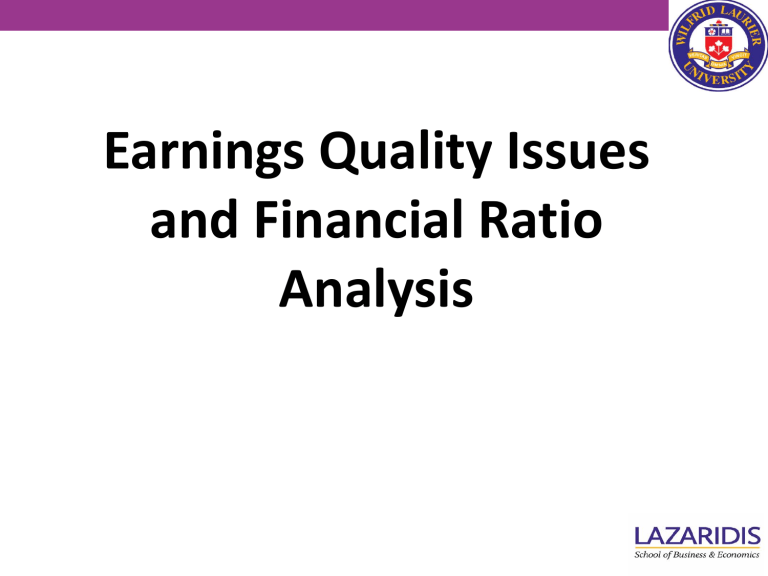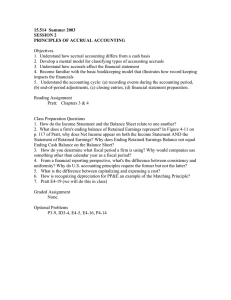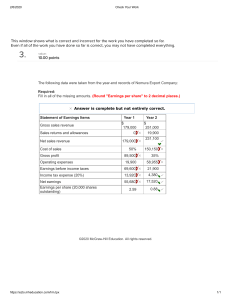
Earnings Quality Issues and Financial Ratio Analysis Framework for Analysis 1. Establish the objectives – Input • Analyst’s perspective (evaluate a debt or equity investment, or establish a credit rating) • Needs communicated by client or supervisor • Institutional guidelines – Output • Purpose statement and specific questions to be answered • Nature and content of final report • Timetable and budget Framework for Analysis 2. Data collection – Input • Financial statements • Communication with management, suppliers, customers, and competitors – Output • Organized financial information Framework for Analysis 3. Processing the data from Step 2 – Output • Adjusted financial statements • Common-size statements • Ratios • Forecasts 4. Analyzing the data from Steps 2 & 3 – Output • Results of analysis Framework for Analysis 5. Develop and communicate conclusions – Input • Results from analysis using report guidelines – Output • Recommendations 6. Follow-up – Input • Periodically update information – Output • Update analysis and recommendations Understand What You Are Looking At • Awareness of the type of disclosure: 1. Prepared according to GAAP 2. Pro forma information • Earnings disclosures: what earnings are being disclosed? 1. Transitory items 2. Permanent items Earnings Measures • EBITDA Used as a proxy for operating cash flow but ignores tax, interest, and working capital changes • EBT • Operating income • Income from continuing operations Excludes tax effects Profits from operating activities EBIT Income after unusual or infrequent items and tax, but before extraordinary items and discontinued operations Earnings Measures • Net income • Pro forma income Income after all items below and above the line have been included The firm’s own measure of “operational earnings”—removes what management considers to be transitory items (view with suspicion) IFRS SELF-TEST QUESTION Which of the following is not reported in an income statement under IFRS? a. Discontinued operations. b. Extraordinary items. c. Cost of goods sold. d. Income tax. IFRS SELF-TEST QUESTION Which of the following is not reported in an income statement under IFRS? a. Discontinued operations. b. Extraordinary items. c. Cost of goods sold. d. Income tax. Read the Fine Print • Don’t just view the financial statements – MDA – Footnotes Most of the detailed explanations can be found here • Includes information on significant items, accounting policies, estimates, and judgements (and changes to them) • incomprehensible footnotes or MDA = Warning sign Be Skeptical • If the firm’s results are consistently better than industry averages or the economy • If so, look for: 1. Competitive advantage (a positive) 2. Earnings management (a negative) • Studies suggest mean earnings grow at the same rate as GDP • Very small percent of companies exceed median growth for a significant period Check for Cash Flow • Operating cash flow is less easy to manipulate than earnings • Point: In the long-run, the growth rates of NI and CFO should be similar – Look at the quality of income ratio = Net CFO/Net income. A ratio near 1 is good. – Quality of income deteriorates prior to bankruptcy • Problem: In the short-run, the growth rates may differ significantly because of: – Seasonality – Cyclicality Okay – Life cycle – Firm-specific factors – Earnings manipulation Problem Understand the Risks • Business risk: sales volatility operating leverage • Financial risk: Capital structure • More specific risk disclosed in 10K filing: – Interest rate risk – Currency risk – Collectability of AR – Price risk of inputs (raw materials, etc.) – Contingencies Evaluating Financial Reporting Quality Two bases for preparing accounting statements • Cash flow basis – Transactions recorded when cash is paid or received – cash payment reduces net income in year of investment especially for long term investments • Accruals basis – Revenues and expenses triggered by the earnings process – Revenues—increase in net assets – Expenses—decreases in net assets – Long term investments are capitalized and expensed over the life of the asset Accrual vs. Cash Accounting • Cash flow basis – No subjectivity – Easy to verify • Accruals basis – Subjective measurement – Better indication of “true” value creating activities – More timely and relevant information for decision making (e.g., recording of sales on credit = future cash flow owed by customer) – Potential earnings management Knowledge check A manufacturing firm purchases equipment for use in its operations. With regard to recording the purchase using the cash basis versus the accrual basis of accounting, which of the following statements is most appropriate? A. With the cash basis, revenues and expenses relating to the equipment are generally recognized in different periods. B. With the cash basis, revenues and expenses relating to the equipment are generally recognized in the same period. C. With the accrual basis, the cost of the equipment is allocated to the cash flow statements over the asset's life. Knowledge check A manufacturing firm purchases equipment for use in its operations. With regard to recording the purchase using the cash basis versus the accrual basis of accounting, which of the following statements is most appropriate? A. With the cash basis, revenues and expenses relating to the equipment are generally recognized in different periods. B. With the cash basis, revenues and expenses relating to the equipment are generally recognized in the same period. C. With the accrual basis, the cost of the equipment is allocated to the cash flow statements over the asset's life. Accruals Accruals are created from 1. Unearned (deferred) revenue – Payment is received before providing goods or services – Increases assets and liabilities 2. Accrued revenue – Revenue has been earned but not yet collected – Increases assets and equity Creating Accruals (continued) 3. Deferred expenses – Costs that benefit future periods – Increases asset 4. Accrued expense – Expenses incurred but not yet paid – Increases liabilities and decreases equity Earnings Persistence Earnings persistence is the durability of earnings. • Why do we care about earnings persistence? – Tells us how continuous those earnings will be in the future. • Earnings can be measured using either accruals or cash basis • Accrual earnings is less persistent than cash earnings. – Because accruals tend to mean revert due to: • Strategic manipulation • Unintentional errors • Analysts should assign lower weight to accruals-based earnings as compared to cash earnings while forecasting future earnings • Price multiple for cash earnings would be higher than accruals-based earnings multiples. Mean Reversion • Empirical observation: earnings at extreme levels revert to normal over time Logic: Excess returns (economic profit) New industry entrants Increased competition Margins reduce • Earnings = cash flow and accrual components Earnings comprised of accruals → lower future earnings and cash flows The greater the accrual component of earnings, the faster reversion occurs Manipulation Incentives “Earnings Game” Strategic manipulation of earnings is due primarily to the following: Capital markets: • Meet or exceed current expectations – Manipulation of reported earnings • Manage expectations going forward – Using communication with analysts to move consensus sell-side forecasts Pattern of forecast errors: • Initial forecasts optimistic • Later forecasts pessimistic – Positive earnings surprises on announcement of results Manipulation Incentives Remuneration contracts • Bonus payments • Stock options Debt covenants • Avoid technical defaults • Interest costs tied to financial performance Financing • Prior to issuing of debt or equity (“window dressing”) Disciplining Mechanisms • • • • • • External auditors Internal audit, audit committee Management certification Lawyers—class action lawsuits Regulators General market scrutiny Earnings Quality Quality = persistence/sustainability • EQ refers to the ability of a firm’s reported earnings to predict its future earnings. • Reported earnings are affected by many factors including aggressive vs. conservative choices: – S/L vs. accelerated deprecation – Accrual choices – requiring some judgement. • These accruals naturally self correct over time: • Insufficient depreciation expense → higher impairment charge • Insufficient bad debt provision → higher future bad debt write offs Measuring Earnings Quality Earnings have a cash flow component and an accrual component Aggregate accruals = Accrual Cash based – earnings earnings Aggregate accruals can be measured using either a: • Balance sheet approach • Cash flow statement approach There is an inverse relationship between accruals and earnings quality Balance Sheet Based Accruals Accruals ratio = Aggregate accruals (NOAt + NOAt–1) / 2 *Also includes cash equivalents and marketable securities Net operating assets (NOA) Aggregate accruals = (Total assets – cash*) – (Total liabilities – total debt) = NOAt – NOAt–1 Balance Sheet Accruals Example Use the following data to calculate the accruals ratio: 2009 2008 Cash $8,800 $8,000 Receivables 14,000 12,000 Inventory 16,800 16,000 PP&E 55,200 52,000 $94,800 $88,000 Payables Short-term debt Long-term debt Capital stock Retained earnings $7,040 $6,400 10,576 9,600 60,000 60,000 9,200 8,000 7,984 4,000 $94,800 $88,000 Net Operating Assets Total assets Cash Operating assets 2009 $94,800 (8,800) $86,000 2008 $88,000 (8,000) $80,000 Total liabilities Short-term debt Long-term debt Operating liabilities $77,616 (10,576) (60,000) $7,040 $76,000 (9,600) (60,000) $6,400 Net operating assets $78,960 $73,600 Balance Sheet Based Accruals – Solution Aggregate accruals Accruals ratio = $78,960 – $73,600 = $5,360 $5,360 = ($78,960 + $73,600) / 2 = 7.0% Cash Flow Based Accruals Aggregate accruals = NI – (CFOt + CFIt) Issue—different treatment of finance costs and dividends under IAS and U.S. GAAP Interest Paid: IFRS –O or F; US GAAP – F Dividend Paid: IFRS – O or F; Div R – O or I US GAAP – F; Div R - O Accruals ratio Aggregate accruals = (NOAt + NOAt–1) / 2 Income Statement Revenues Cost of goods sold Depreciation SG&A Interest Taxes Net income 2009 $ 76,000 (48,000) (6,000) (4,000) (4,800) (5,760) $7,440 Cash Flow Statement Net income Depreciation Increase receivables Increase inventory Increase payables CFO CFI CFF Change in cash 2009 $7,440 6,000 (2,000) (800) 640 $11,280 (9,200) (1,280) $800 Free Cash Flow (FCF) • • • • FCF is cash available for discretionary uses Frequently used to value firms FCFF = CFO + Int (1 – T) – FCInv FCFE = CFO – FCInv + Net debt increase Cash Flow Based Accruals – Solution Aggregate accruals Accruals ratio = $7,440 – ($11,280 – $9,200) = $5,360 $5,360 = ($78,960 + $73,600) / 2 B/S and cash flow accruals can differ because of: Non-cash acquisitions Currency translation Inconsistent classification between B/S and cash flow = 7.0% Aggregate Accruals Effectiveness The accruals ratio has been shown to be effective in identifying earnings quality issues For example: 1. Companies restating earnings had highest aggregate accruals (Richardson, Tuna, Wu (2002)): Impact was a market value decline of 10% following restatement 2. Aggregate accruals = leading indicator of SEC enforcement actions (Richardson, Sloan, Soliman, Tuna (2006)) Observation was that accruals peak 2 years prior to enforcement action Common Accounting Issues Revenue Recognition Range of problems: 1. Recognition of sale before completion of earnings process 2. Recognition of sale without assurance of payment Estimates: Credit sales Deferred/unearned revenue Warranty provisions Sales returns Accelerating Revenue Range of problems: 1. Recognition of sale before completion of earnings process (assessing the completion date) 2. Lowering credit standards 3. Cut-off issues (moving sales between periods) Warning signs: Large ↑ AR Bundled products Large ↓ Unearned Management vested options ITM Revenue Pressure to meet earnings forecasts Disproportionate Raising additional finance revenue in last ¼ Accelerating Revenue Recognizing revenue too early: 1. Bill-and-hold sales 2. Lessor use of sales type lease 3. Recording sales prior to acceptance by customer (sales of equipment prior to installation) 4. Incorrectly using percent-of-completion method for longterm contracts Ratio Detection ↑ Sales to cash collected from customers Days sales outstanding Sales = Revenue – Δ AR + Δ deferred revenue 365 = AR T/O Sales Avg AR Classification of Nonrecurring or Nonoperating Revenue as Operating Range of problems: • Investment income • Divestiture of non-current assets • NB. No accrual or deferral reversal in later periods Warning signs: • Temporary inconsistency of items included within definition of operating income Expense Recognition – Understating Expenses Range of problems: 1. Discretion over depreciation and amortization 2. Impairment recognition 3. Application of lower of cost and fair value rules Warning signs: Δ of methods or lives – depreciation (disclosed in footnotes) Conference calls – additional information LIFO liquidations 365 DOH = Inventory obsolescence Inv T/O Expense Recognition – Deferring Expenses Range of problems: • Capitalization of operating expenses Warning signs: • ↑ Net non-current assets (B/S broad measure accruals) • Consider asset growth in the context of expected sales and margin growth • Software development costs – discretion Classification of Operating Expenses as Nonrecurring or Non-Operating Range of problems: • Incorrect classification reduces COGS or SG&A Warning signs: • Company has genuine special items that can be piggybacked • Changes in operating profit margin or gross margin accompanied by spikes in special items Big Bath Provisions Range of problems: 1. Impairments – future I/S improvements via ↓ depreciation 2. Restructuring or impairment charges reversed in subsequent periods 3. Use of high or low bad debt reserves out of line with peers Cash Flow Statement Issues Classification issues: • Definition of cash and cash equivalents • Marketable liquid investments may be CFI • Solution: Operating cash flows = CFO + CFI Omitted investing and financing activities: • Non-cash acquisitions (e.g., acquiring PP&E with seller provided financing) Solution: utilize B/S based measure of aggregate accruals • Operating leases Solution: capitalize Off-Balance-Sheet Liabilities Range of problems: • Assets and liabilities avoiding recognition: – Operating leases – Sale of AR with recourse – Take or pay/through put agreements – Equity accounted SPVs Warning signs: Firms following U.S. GAAP must report future cash flow obligations of operating leases – analyst should discount to PV and restate balance sheet Balance Sheet Goodwill Goodwill: 1. FMV adjustments on acquisition 2. Future impairments Warning signs: Goodwill reported and not impaired for companies where market cap < book value Fair Value Reporting • IASB and FASB move to embrace fair value accounting • Issues: – Some assets have readily identified fair values • Listed equity – Some assets don’t have readily identified fair values (assets with no actively traded secondary markets) • Unlisted equity • Specialized equipment – Valuation models = discretionary inputs Foundation Concepts • Note: Many of the “adjustments” mentioned in this topic review are discussed elsewhere in the curriculum • The point of this topic review is to “put it all together” (i.e., to detail how to take the individual adjustments and restate the financial statements) before calculating ratios Knowledge check An analyst finds return on equity (ROE) a good measure of management performance and wants to compare two firms: Firm A and Firm B. Firm A reports net income of $3.2 million and has a ROE of 18. Firm B reports income of $16 million and has an ROE of 16. A review of the notes to the financial statements for Firm A, shows that the earnings include a loss from smelting operations of $400,000 and that the firm has exited this business. In addition, the firm sold the smelting equipment and had a gain on the sale of $300,000. A similar review of the notes for Firm B discloses that the $16 million in net income includes $2.6 million gain on the sale of no longer needed office property. Assume that the tax rate for both firms is 36%, and that the notes describe pretax amounts. Which of the following is closest to the "normalized" ROE for Firm A and for Firm B, respectively? A. 16.0 and 18.0. B. 18.4 and 14.3. C. 17.1 and 16.9. Knowledge check An analyst finds return on equity (ROE) a good measure of management performance and wants to compare two firms: Firm A and Firm B. Firm A reports net income of $3.2 million and has a ROE of 18. Firm B reports income of $16 million and has an ROE of 16. A review of the notes to the financial statements for Firm A, shows that the earnings include a loss from smelting operations of $400,000 and that the firm has exited this business. In addition, the firm sold the smelting equipment and had a gain on the sale of $300,000. A similar review of the notes for Firm B discloses that the $16 million in net income includes $2.6 million gain on the sale of no longer needed office property. Assume that the tax rate for both firms is 36%, and that the notes describe pretax amounts. Which of the following is closest to the "normalized" ROE for Firm A and for Firm B, respectively? A. 16.0 and 18.0. B. 18.4 and 14.3. C. 17.1 and 16.9.



